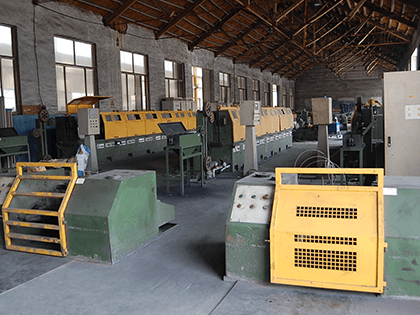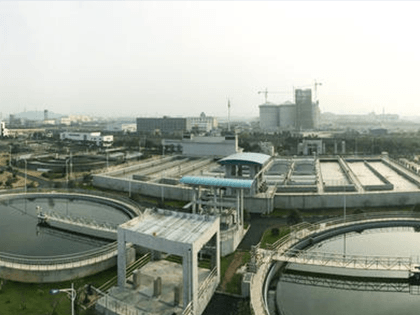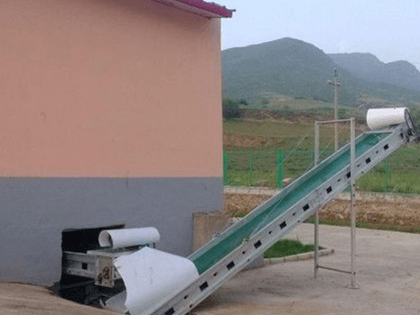Pollutants should be controlled for sludge incineration disposal
Author: Taida machine Release time:2016-08-17
Reading guidance:Sludge is a kind of harmful matter produced in disposal process. It contains organic residual pieces, pathogenic microorganism heavy metals. It can be regarded as a kind of resources, but also cause po
Sludge is a kind of harmful matter produced in disposal process. It contains organic residual pieces, pathogenic microorganism heavy metals. It can be regarded as a kind of resources, but also cause pollution. The reason why sludge cause pollution is because if harmful matters are discharged, secondary pollution will be caused. The reason why we can regard sludge as a kind of resource is rich nutrients contained in sludge. These nutrients can improve soil activity. After dehydration, sludge holds certain thermal value which is similar with that of coal. However, while it is disposed, harmful matters in sludge may be discharged into air. As a result, emission control should be carried out.
Emission and control of heavy metal
There are many kinds of heavy metals contained in sludge. The data of the total amount of heavy metals in sludge at home and abroad, the heavy metals in the sludge is mainly oxides, hydroxides and silicates, are not soluble salt or organic complexes, followed by sulfides. Heavy metals can be discharged in the form of solid state condensation in larger particles in the incineration process, can not be completely condensed in larger particles on the the gaseous and aerosol expelling incinerator, hazards of heavy metals in gaseous or aerosol form discharged to the human body. In order to control the heavy metals in gaseous or aerosol form from the incinerator after processing system can be run, the accumulation of heavy metals in bottom ash with large granularity, alleviate the pressure of heavy metal pollution on the environment.
The factors affecting the emission of heavy metals in sludge incineration process is mainly incineration temperature and adsorbent applied. The effect of temperature on the burning of external heavy metals is mainly reflected in the different burning temperature and the effect of heating rate on heavy metal trapping and improve the temperature of incineration slag phase change of two aspects, the internal impact is mainly reflected in the thermodynamic stability of heavy metal compounds. Absorbents such as limestone in the incineration process, enhance the ability to capture of kaolin and other heavy metals, the heavy metal condensation rapid enrichment on the adsorbent, the bottom ash deposition in the lower atmosphere, to the volatilization of heavy metals, reduce the harm to the human body and the atmosphere, is the safest and most ideal way for removing heavy metals.
Formation and control of dioxin
The formation mechanism of dioxin is quite complex, in the process of sludge incineration may generate way mainly has three kinds: one is contains pcdd/pcdf compounds in the combustion chamber of incomplete combustion; two chlorine containing compounds (such as chlorophenols, chlorobenzene etc.) will be hot solution of rearrangement reaction in 500 to 800 DEG C temperature rapidly (0.1 ~ 0.2 s) produce large amounts of dioxin, the so-called "solid-state synthesis mechanism", and at high temperature (higher than 850 DEG C) the decomposition rate of dioxins is far greater than the rate by the precursor for the synthesis of dioxins. Three is composed of inorganic chloride and organic compounds in the catalyst in the reaction, including the reaction from scratch and out of phase the precursor formation mechanism in fly ash on metal compounds in the low temperature range (250 to 400 DEG C) catalyzing the formation of dioxin.
The formation of dioxins by incineration temperature, residence time, oxygen content of sulfur / chlorine, as long as the strict control of the production conditions and process parameters, can effectively control the generation of dioxin. In the production control of combustion temperature and residence time can effectively control the dioxin formation. The dioxin resynthesis peak temperature range 250 ~ 500 degrees, so by high flow rate of flue gas, the size of the boiler and the quenching reactor combined directly or using the quench tower and other measures to avoid the rapid cooling of the flue gas, the maximum temperature range of dioxin formation rate, the incineration flue gas rapid cooling to 200 DEG C, thereby reducing the formation of dioxins. Dioxins decrease the oxygen content decreased, no O2 is not a 50% reduction in the O2 generation of dioxin, can reduce formation of dioxins again 30%, so in general engineering proposals to control oxygen content in 8% Below. The chlorine of dioxin is mainly exists in the form of Cl2 and HCl or, two important parameters of incomplete combustion of chlorine content and s/cl ratio is pcdd/pcdf release in formation with chlorine content in the sludge increased with increasing amount of emission in flue gas pcdd/pcdf. Therefore, by the addition of Cao and limestone to control the generation of dioxin precursor HCl in order to achieve the purpose of control. The formation of Cl2 is generated by a deacon reaction, SO2 can inhibit the Deacon reaction. With the increase s/cl than the sludge, dioxin and fur-an formation concentration decreased, which inhibits the generation of dioxin.
Emission and control of acid gas
Recent haze caused by environmental impact, so that flue gas discharge standards is becoming more and more serious. Incineration of sludge produced in the process of flue gas containing NOx, Sox and other acidic atmospheric pollutants, the composition of these pollutants emission and sludge incineration, burning conditions.
Incineration of sludge produced in the process of NOx points for fuel and combustion type two categories and the combustion type mainly. The study found that by controlling the combustion temperature can reduce NOx generation. By adding alkaline sorbent can adsorb NOx. Therefore, through the study on flue gas selective catalytic reaction reduce NOx emissions to the air.
Generation of Sox during incineration is mainly due to the elemental sulfur in the sludge in the incineration process and oxygen compounds, combustion desulfurization process by adding sulfur fixing agent to fixed, by flue gas desulfurizing device for flue gas purification in addition to sulfur. At present a lot of research show that sulfur element and the sludge incineration control of heavy metals and dioxins control has some relevance, therefore in the control of heavy metals and dioxins while taking into account the Sox removal is consistent with the requirements of clean burning.
Emission and control of lime-ash
Sludge incineration smoke including black smoke, fly ash and ash of three parts, heavy metals in sludge in burning after deposition in incineration ash (including the bottom ash and fly ash), the sludge incineration ash is very harmful. Therefore, for fly ash safe disposal is sludge incineration ash environmental safety an integral part of, through the molten slag processing technology the ash into the temperature for more than 1200 DEG C melting furnace after melting, pcdd/ PCDF decomposition rate reaches 99.77%, is a more effective ash handling means and guarantee of sludge incineration environmental safety.
At present, both China and foreign countries increase sludge reduction degree of the highest incineration technology research. However, the incineration technology is not mature. The penetration rate is low, incineration disposal of funds and incineration disposal technology lacking, and for sludge disposal in the process of tail gas treatment level is relatively backward, resulting low use ratio in our incineration project.
Emission and control of heavy metal
There are many kinds of heavy metals contained in sludge. The data of the total amount of heavy metals in sludge at home and abroad, the heavy metals in the sludge is mainly oxides, hydroxides and silicates, are not soluble salt or organic complexes, followed by sulfides. Heavy metals can be discharged in the form of solid state condensation in larger particles in the incineration process, can not be completely condensed in larger particles on the the gaseous and aerosol expelling incinerator, hazards of heavy metals in gaseous or aerosol form discharged to the human body. In order to control the heavy metals in gaseous or aerosol form from the incinerator after processing system can be run, the accumulation of heavy metals in bottom ash with large granularity, alleviate the pressure of heavy metal pollution on the environment.
The factors affecting the emission of heavy metals in sludge incineration process is mainly incineration temperature and adsorbent applied. The effect of temperature on the burning of external heavy metals is mainly reflected in the different burning temperature and the effect of heating rate on heavy metal trapping and improve the temperature of incineration slag phase change of two aspects, the internal impact is mainly reflected in the thermodynamic stability of heavy metal compounds. Absorbents such as limestone in the incineration process, enhance the ability to capture of kaolin and other heavy metals, the heavy metal condensation rapid enrichment on the adsorbent, the bottom ash deposition in the lower atmosphere, to the volatilization of heavy metals, reduce the harm to the human body and the atmosphere, is the safest and most ideal way for removing heavy metals.
Formation and control of dioxin
The formation mechanism of dioxin is quite complex, in the process of sludge incineration may generate way mainly has three kinds: one is contains pcdd/pcdf compounds in the combustion chamber of incomplete combustion; two chlorine containing compounds (such as chlorophenols, chlorobenzene etc.) will be hot solution of rearrangement reaction in 500 to 800 DEG C temperature rapidly (0.1 ~ 0.2 s) produce large amounts of dioxin, the so-called "solid-state synthesis mechanism", and at high temperature (higher than 850 DEG C) the decomposition rate of dioxins is far greater than the rate by the precursor for the synthesis of dioxins. Three is composed of inorganic chloride and organic compounds in the catalyst in the reaction, including the reaction from scratch and out of phase the precursor formation mechanism in fly ash on metal compounds in the low temperature range (250 to 400 DEG C) catalyzing the formation of dioxin.
The formation of dioxins by incineration temperature, residence time, oxygen content of sulfur / chlorine, as long as the strict control of the production conditions and process parameters, can effectively control the generation of dioxin. In the production control of combustion temperature and residence time can effectively control the dioxin formation. The dioxin resynthesis peak temperature range 250 ~ 500 degrees, so by high flow rate of flue gas, the size of the boiler and the quenching reactor combined directly or using the quench tower and other measures to avoid the rapid cooling of the flue gas, the maximum temperature range of dioxin formation rate, the incineration flue gas rapid cooling to 200 DEG C, thereby reducing the formation of dioxins. Dioxins decrease the oxygen content decreased, no O2 is not a 50% reduction in the O2 generation of dioxin, can reduce formation of dioxins again 30%, so in general engineering proposals to control oxygen content in 8% Below. The chlorine of dioxin is mainly exists in the form of Cl2 and HCl or, two important parameters of incomplete combustion of chlorine content and s/cl ratio is pcdd/pcdf release in formation with chlorine content in the sludge increased with increasing amount of emission in flue gas pcdd/pcdf. Therefore, by the addition of Cao and limestone to control the generation of dioxin precursor HCl in order to achieve the purpose of control. The formation of Cl2 is generated by a deacon reaction, SO2 can inhibit the Deacon reaction. With the increase s/cl than the sludge, dioxin and fur-an formation concentration decreased, which inhibits the generation of dioxin.
Emission and control of acid gas
Recent haze caused by environmental impact, so that flue gas discharge standards is becoming more and more serious. Incineration of sludge produced in the process of flue gas containing NOx, Sox and other acidic atmospheric pollutants, the composition of these pollutants emission and sludge incineration, burning conditions.
Incineration of sludge produced in the process of NOx points for fuel and combustion type two categories and the combustion type mainly. The study found that by controlling the combustion temperature can reduce NOx generation. By adding alkaline sorbent can adsorb NOx. Therefore, through the study on flue gas selective catalytic reaction reduce NOx emissions to the air.
Generation of Sox during incineration is mainly due to the elemental sulfur in the sludge in the incineration process and oxygen compounds, combustion desulfurization process by adding sulfur fixing agent to fixed, by flue gas desulfurizing device for flue gas purification in addition to sulfur. At present a lot of research show that sulfur element and the sludge incineration control of heavy metals and dioxins control has some relevance, therefore in the control of heavy metals and dioxins while taking into account the Sox removal is consistent with the requirements of clean burning.
Emission and control of lime-ash
Sludge incineration smoke including black smoke, fly ash and ash of three parts, heavy metals in sludge in burning after deposition in incineration ash (including the bottom ash and fly ash), the sludge incineration ash is very harmful. Therefore, for fly ash safe disposal is sludge incineration ash environmental safety an integral part of, through the molten slag processing technology the ash into the temperature for more than 1200 DEG C melting furnace after melting, pcdd/ PCDF decomposition rate reaches 99.77%, is a more effective ash handling means and guarantee of sludge incineration environmental safety.
At present, both China and foreign countries increase sludge reduction degree of the highest incineration technology research. However, the incineration technology is not mature. The penetration rate is low, incineration disposal of funds and incineration disposal technology lacking, and for sludge disposal in the process of tail gas treatment level is relatively backward, resulting low use ratio in our incineration project.
:Pretreatment technology of sludge :Use composting method to disposal life sludge Sludge composting can refer to two methods
Relevant news
- 2016-01-12OSC-II Model Sludge Dryer Deliv
- 2016-01-1215T/Day Aerobic Dynamic Ferment
- 2016-01-12Matters Should Be Paid Attentio
- 2016-01-12Methods exploration of chemical
- 2016-01-12Analysis of circulating fluid b
Industry trends
- 2016-01-12Comparison Between Different Sl
- 2016-01-12Adding Calcium and Stable Dispo
- 2016-01-12Sludge Treatment: Methods for S
- 2016-01-12Use Dyeing Sludge As Resource
- 2016-01-12Current situation of sludge dis
Hot spots
Hot-sale products

- Leather Industry Sludge Drying
Production Capacity:1-2200t/h

- Welding Plating Sludge Drying S
Production Capacity:1-2200t/h

- Municipal Sludge Drying Solutio
Production Capacity:1-2200t/h

- Manure Sludge Drying Solution
Production Capacity:1-2200t/h
 中文
中文 English
English Home
Home
